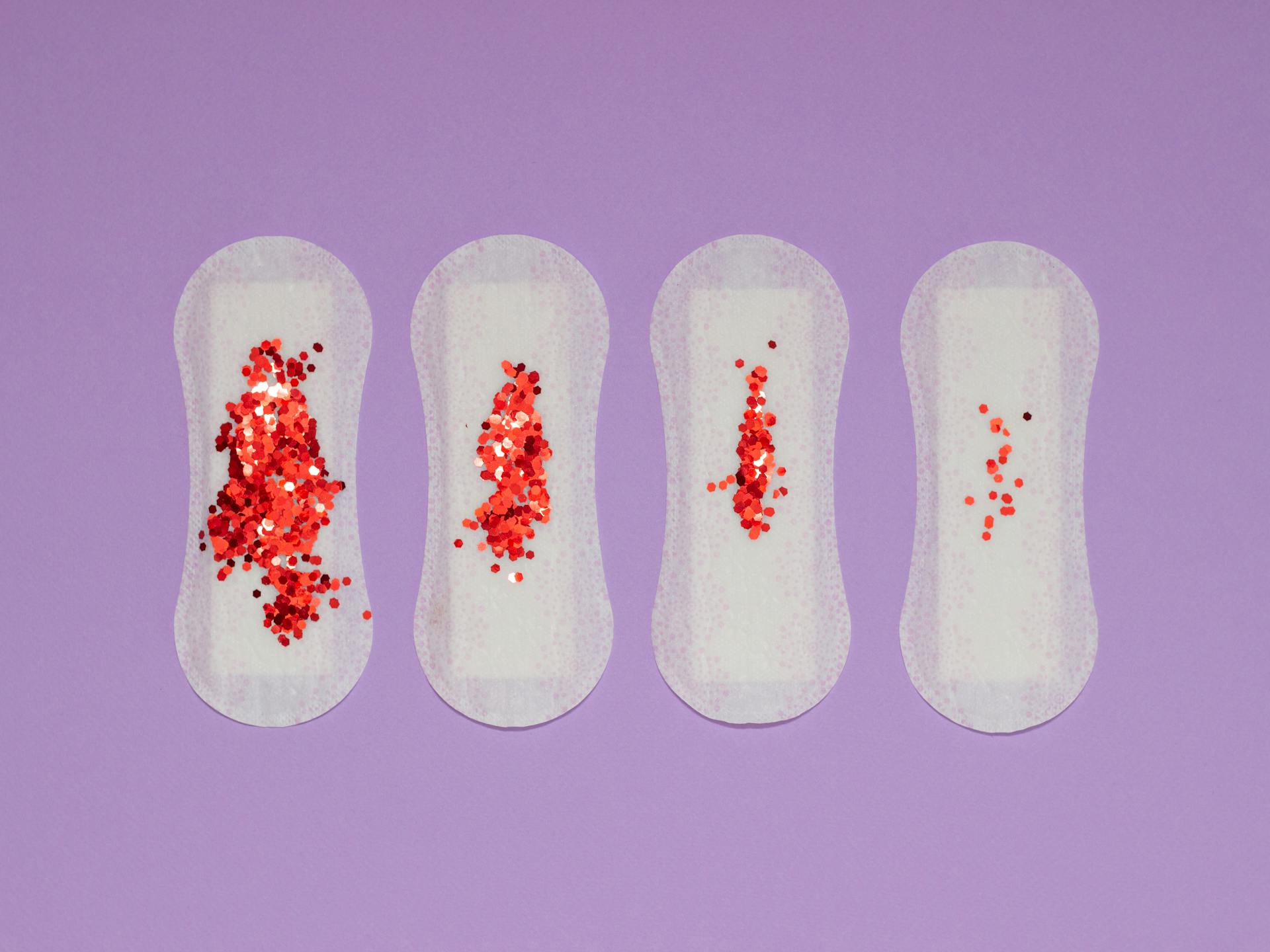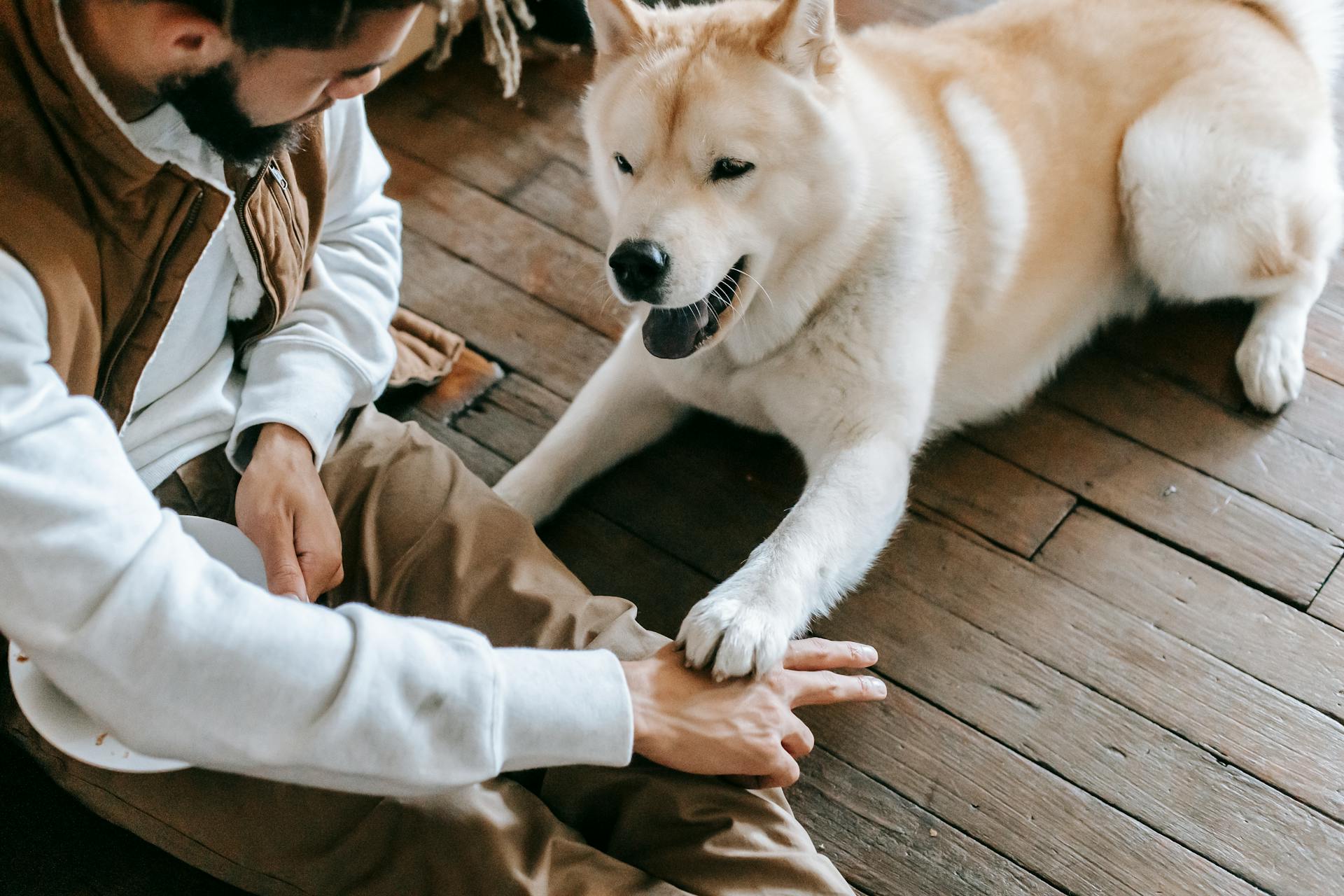
If you're at your wit's end with your dog's potty training, it's time to consider a last resort approach. According to research, up to 20% of dogs require more time and effort to learn good potty habits.
Consistency is key when it comes to potty training, but sometimes even the most diligent owners struggle to see results. This is where crate training comes in, as it can help prevent accidents and make the learning process more manageable.
As we'll discuss later, crate training can be an effective tool, but it's not a one-size-fits-all solution. Every dog is different, and what works for one may not work for another.
A fresh viewpoint: It's Your Choice Dog Training
Understanding Dog Behavior
Dogs are creatures of habit and instinct, and these natural tendencies play a significant role in their behavior and training.
Their innate desire to keep their living space clean makes it less likely for them to relieve themselves in areas where they sleep or eat.
A routine is crucial, as dogs thrive on predictability and establishing a set schedule for eating, playing, and going outside can help them understand what's expected of them.
Consistency in their daily routine will regulate their internal clocks, making it easier for them to adapt to designated potty times.
Pay close attention to your dog's signals, as many dogs will show signs like pacing, whining, or sniffing when they need to go out.
Recognizing these cues and responding promptly will reinforce good habits and prevent accidents.
Training Methods
Creating a positive association with the crate can be as simple as feeding your dog in it or hiding treats inside. This will help your dog view the crate as a welcoming space.
Regular bathroom breaks are essential to establish a routine and reinforce the connection between being outside and relieving themselves. Take your dog out frequently to make this association clear.
Positive reinforcement is key to encouraging your dog to repeat good behavior. Respond with enthusiastic praise and a treat every time your dog successfully goes to the bathroom outside.
Additional reading: Training Dog to Pee outside
Outdoor Training
Your puppy uses their nose to decide where they should potty. Their sense of smell is incredibly strong, somewhere between 10,000 and 100,000 times more sensitive than ours.
To prevent accidents, it's essential to clean up effectively. Enzymatic cleaners like TURFtastic break down urine at a molecular level, so even your dog can't detect the scent.
Dogs aren't trying to get back at you when they have accidents in the house. They're simply not built that way, and there could be underlying medical conditions or other factors at play.
Your dog's history before living with you can affect their development and potty training. It's possible that they weren't properly trained or had accidents in the past.
A strong biological trigger for dogs is their own scent. If you don't clean accidents properly, your dog will keep returning to the same spot.
Additional reading: Pheasant Scent Dog Training
Accidents and Issues
Accidents are a normal part of the potty training process, and it's essential to respond in a way that doesn't confuse your dog.
Punishing your dog after an accident won't help, as they won't understand the reason for the punishment. Instead, focus on interrupting the behavior gently if you catch them in the act and immediately take them outside.
Cleaning up accidents thoroughly is crucial, especially if you miss an accident. Use an enzymatic cleaner to remove the scent and discourage your dog from using that spot again.
Your dog's nose is incredibly sensitive, detecting scents that are masked to us. To properly clean up accidents, use a powerful enzymatic cleaner like TURFtastic, which breaks down urine at a molecular level, so even your dog can't detect the scent.
A unique perspective: Why Use a Clicker for Dog Training
Look for Signs
Dogs will start giving off some telltale signs when looking for a place to use the bathroom. Common signs include sniffing more than usual.
If you ignore these signs, they're going to have an accident in the house.
Circling is another obvious sign that your dog needs to go outside. It's a clear indication that they're looking for a place to do their business.
Wandering off is also a common behavior when dogs are trying to find a suitable spot to relieve themselves.
Whining and sitting by the door are other signs that your dog needs to go outside.
Recommended read: Training Dog to Ring Bell to Go Out
The 4 Causes of Dog Potty Training Issues
Dogs can't feel spite and certainly don't potty in the house as petty revenge. It's usually not something that's your fault, save for a few occasions when your training lacks consistency.
There are many causes of dog potty training regression, and it's impossible to tell at a glance what's wrong without additional context. It'll take some sleuthing and careful observation to narrow the possibilities.
Your dog's history before living with you can affect their development and lead to potty training issues. This can be due to underlying illnesses or medical conditions that cause persistent accidents.
A dog's nose is somewhere between 10,000 and 100,000 times more sensitive than ours, and they use it to decide where they should potty. This means that cleaners often mask bad odors to us, but your dog can smell right through them.
To properly clean up accidents, you'll need to use an enzymatic cleaner like TURFtastic, which breaks urine down at a molecular level, so that not even dogs can detect their "uh-oh's".
Check this out: What Treats to Use for Dog Training
Dealing with Accidents Positively

Accidents will happen, but how you respond is crucial. Never punish your dog after finding an accident, they won't understand the reason for the punishment.
Focus on interrupting the behavior gently if you catch them in the act and immediately take them outside. This approach will help prevent future accidents.
Your dog's nose is incredibly sensitive, between 10,000 and 100,000 times more sensitive than ours. This means cleaners that mask bad odors to us won't fool your dog.
To properly clean up accidents, use an enzymatic cleaner like TURFtastic, which breaks down urine at a molecular level. This will eliminate the scent and discourage your dog from using that spot again.
Ignoring your dog's signs, such as sniffing more than usual, circling, or whining, can lead to accidents in the house. If you notice these signs, take action and get your dog outside.
Creating a positive association with the confined area, such as feeding your dog in their crate or hiding treats inside, can help make it a comfortable space.
Explore further: Dog Diaper Training
Weaning Your Dog
Weaning your dog from a confinement area is a crucial step in helping them adjust to life indoors. Start by removing any flooring or pads you placed inside the pen, making them smaller before taking them away altogether.
Leaving the pen door open is a good next step. Gradually remove it altogether to give your dog a sense of freedom and independence.
Accidents will still happen, so be vigilant about catching them indoors and redirecting your dog outdoors to do their business.
If this caught your attention, see: Playpen Dog Training
Potty Pad Alternatives
If you're struggling to potty train your dog, you may have considered using potty pads as a last resort. Potty pads are a common solution, but they're not the only option.
Some owners have reported success with outdoor potty areas, which can be created in a designated section of your yard. This allows your dog to learn to go outside in a specific spot, just like a regular potty training area.
A different take: Dog Training Pads Xl
For dogs with mobility issues or health concerns, indoor potty areas can be a more practical solution. These areas can be created using a litter box or a specific potty pad system.
However, some owners have found that using a litter box can be a good alternative to traditional potty pads. This is because litter boxes are often more hygienic and easier to clean than potty pads.
As an alternative to potty pads, you can also consider using newspaper or puppy pads in a designated area. This can be a cost-effective and eco-friendly option for some owners.
Worth a look: Dog House Training Pads
Frequently Asked Questions
How do you stop a dog from peeing and pooping in the house?
To stop a dog from peeing and pooping in the house, immediately take them to their designated bathroom spot and praise them when they finish. Clean up any accidents thoroughly without punishment, and reward good behavior with treats and praise.
Sources
- https://www.dogster.com/dog-training/how-to-potty-train-a-bernese-mountain-dog
- https://www.dogster.com/dog-training/dog-regressing-in-potty-training
- https://peachonaleash.com/housetraining-a-dog-that-refuses-to-potty-outside/
- https://cozzzytogether.com/dogs/last-resort-for-dog-potty-training/
- https://porchpotty.com/blogs/news/dog-wont-pee-outside
Featured Images: pexels.com


